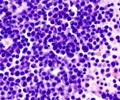Childhood acute lymphoblastic leukemia (ALL) can be successfully treated using a carefully personalized chemotherapy regimen without cranial radiation, investigators at St.
Childhood acute lymphoblastic leukemia (ALL) can be successfully treated using a carefully personalized chemotherapy regimen. This can be done without cranial radiation, investigators at St. Jude Children's Research Hospital have found. Such radiation of the brain was once a standard ALL treatment to prevent recurrence of the leukemia in the central nervous system (CNS).
Despite radiation's success in treating ALL, it produces side effects that include second cancers, stunted growth, hormone imbalances and cognitive deficits. Optimized use of anticancer drugs, especially those instilled directly into the spinal fluid, have enabled clinicians to reduce radiation use, and only patients at highest risk for relapse have received cranial radiation.Now, St. Jude researchers have established that radiation can be safely eliminated in all patients with the use of highly effective chemotherapy regimens. The investigators reported their findings in the June 25, 2009, issue of the New England Journal of Medicine.
"Cranial radiation was an invaluable treatment when it was introduced by St. Jude oncologists in the mid-1960s," said Ching-Hon Pui, M.D., chair of the St. Jude Department of Oncology and an American Cancer Society Professor. "It controlled CNS leukemia and boosted the cure rate for ALL from only 4 percent to 50 percent. But radiation's side effects led to the steady reduction of dosages and limited use to the highest-risk patients." According to Pui, the paper's lead author, about 20 percent of the approximately 3,400 cases of childhood ALL diagnosed in the U.S. each year are still treated with radiation. In some developing countries, radiation continues to be used in the majority of children with ALL.
"Over the years, St. Jude investigators have identified many important risk factors for CNS relapse and optimized chemotherapy treatment, leading to improved control of CNS relapse," Pui said. "Our success led us to believe that we could safely eliminate the use of cranial irradiation in all patients, and this study clearly demonstrates that to be true."
The study involved 498 patients treated for ALL at St. Jude and Cook Children's Medical Center in Fort Worth, Texas, between 2000 and 2007. The risk of relapse was determined by measurement of residual leukemia cells (so-called minimal residual disease) that were present after remission induction treatment. The measurement of minimal residual disease was used to modify therapy based on the level of disease detected. This measurement is the most important prognostic indicator, according to Dario Campana, M.D., Ph.D., vice chair for laboratory research in the St. Jude Department of Oncology and a co-author of the paper. "The combined use of immunological and molecular methods allows us to study 100 percent of the patients for levels of minimal residual disease, an unprecedented rate of success," Campana said.
St. Jude investigators applied personalized therapy based on molecular genetics of ALL, pharmacogenetic traits of patients and pharmacodynamic principles. "We prospectively determined the activity of drug-metabolizing enzymes of each patient and adjusted the dosage of chemotherapy accordingly," said Mary Relling, Pharm.D., chair of the St. Jude Department of Pharmaceutical Sciences and senior author of the paper. "Personalized therapy that we use avoids over- or under-treatment to maximize the cure rate while preventing excessive toxicity."
Advertisement
"The bottom line is that not only did we get outstanding treatment responses in these patients, many of whom would have otherwise received irradiation, but they will have a better quality of life because of the absence of its side effects," Pui said.
Advertisement
Source-Eurekalert
TAN















